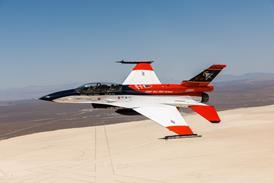Flying over the North Pole is becoming fashionable, but before it can become routine airlines will have to pay to upgrade RussianATC
Graham Warwick/NORTH POLE
More airlines have unveiled plans to use polar routes between North America and Asia, as talks begin on forming an airline-owned company to fund the upgrade of Russian air traffic control (ATC) to increase the capacity of those routes.
Delta Air Lines is the latest to signal its intention to use polar routes, with a 3-4 March demonstration flight from New York Kennedy to Beijing, China, over the North Pole, using a Boeing 777-200ER twinjet.
Three days earlier, Continental Airlines began a daily New York Newark-Hong Kong service over the pole, also using a 777-200ER. Northwest Airlines already serves Beijing from Detroit on the route, using the four-engined Boeing 747-400.
United Airlines, which currently flies over the pole to Hong Kong from Chicago with the 747-400, will begin transpolar services from New York on 1 April. In response, Hong Kong-based Cathay Pacific Airways says it will launch a similar service from New York this year using either the Airbus A340-300s or 747-400s. Cathay also plans Toronto-Hong Kong transpolar service, having conducted a demonstration flight last May using an A340.
Time saving
Air Canada, meanwhile, plans to fly between Vancouver and New Delhi, India, over the pole beginning on 19 October, also using the A340. The airline says the non-stop polar routing will cut more than 4h off the fastest connecting service available. Continental and Delta say they are interested in launching a transpolar 777 service from New York to New Delhi.
Growing interest in the time and fuel savings offered by polar routes is spurring efforts to increase Russian ATC capacity, which limits transpolar flights to two an hour. (Aircraft return via more southerly routes to make best use of tail winds).
Canadian air traffic service provider NavCanada met with 10 airlines on 1 March to outline its proposal to form a special-purpose company, Polar Bridge, to upgrade Siberian ATC infrastructure to increase route capacity to 25 flights an hour - "allowing airlines to fly when they want", says vice-president, engineering, Sid Koslow.
Under NavCanada's proposal, airlines would control Polar Bridge and guarantee the line of credit needed to fund the $33-35 million upgrade. A proportion of the overflight fees generated by increased transpolar flights would go to paying off the loan over five to six years, after which the company would be shut down, says Koslow.
Airlines have asked for more details of the proposal and Koslow says it could take "six to nine months" to negotiate an agreement. NavCanada would act as project manager for the Russian ATC upgrade, which would improve communications, install flight data processing and display systems and provide English language training for controllers.
NavCanada and RusAvia, the Russian civil aviation authority, completed a study last October which showed that implementing polar routes is both feasible and desirable. The study identified 33 North America-Asia city pairs that could benefit from polar routes. Time and cost savings range from 1h 48min and $33,000 for Vancouver-Beijing to 3h 29min and $44,000 for New York-Singapore.
The study calculated that Russia could earn up to $330 million over 10 years in overflight revenues from polar routes, if high traffic estimates are realised. No equivalent figure was produced for airline savings, but carriers could save up to 10 times that amount over the period, making investment in ATC upgrades seem worthwhile.
While talks continue, more airlines are gearing up for transpolar operations. Delta says its New York-Beijing flight validated technical and training requirements for polar extended range twinjet operations (ETOPS). The airline is proceeding with planning for polar flights, although it does not have route authority to serve China from the USA. Instead, Delta plans to begin transpolar services from New York to Narita, Japan, later this year using Boeing MD-11 trijets.
Proving flight
American Airlines, which also lacks US-China route authority, conducted a proving flight from Chicago to Hong Kong in March last year, using the 777-200ER, but has yet to launch a service.
More US-China routes are not expected to be awarded before 2004. Both American and Delta are looking to begin services earlier by wet-leasing aircraft to their local codeshare partners, China Eastern and China Southern respectively.
Continental inaugurated its New York-Hong Kong transpolar service without first conducting a proving flight. Russian observers were on the first revenue flight, and Continental conducted an exercise on the ground in Russia to demonstrate to US authorities its plan to recover passengers and aircraft should a 777 be forced to divert to a Siberian airport.
Twinjet operations are seen as key to the success of polar routes, given the popularity of the 777 with US airlines. So far all 777 transpolar operations have been conducted under 180min ETOPS rules, although available 207min approval would widen the number of suitable diversion airports within reach. Polar ETOPS rules are being finalised by the US Federal Aviation Administration and should be published later this year.
Source: Flight International
















